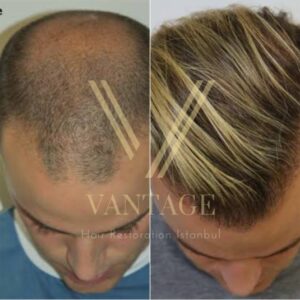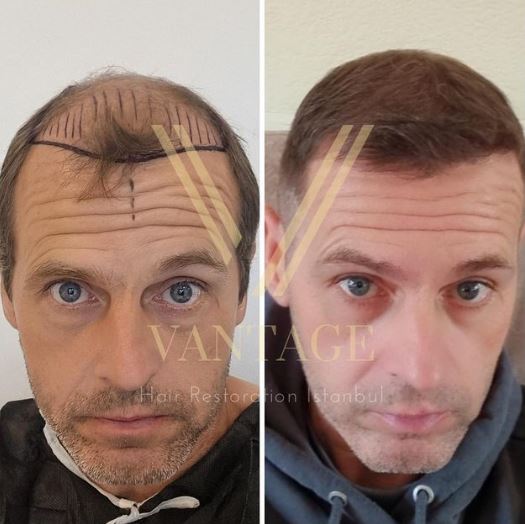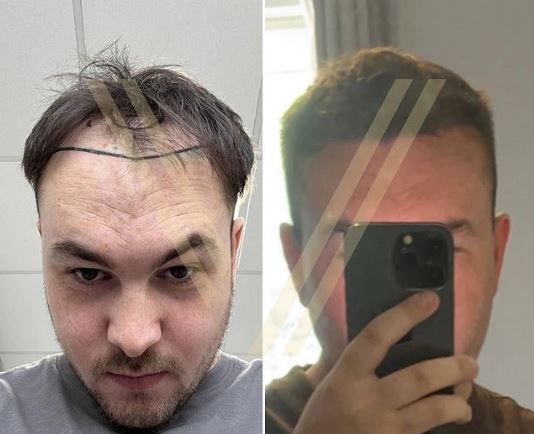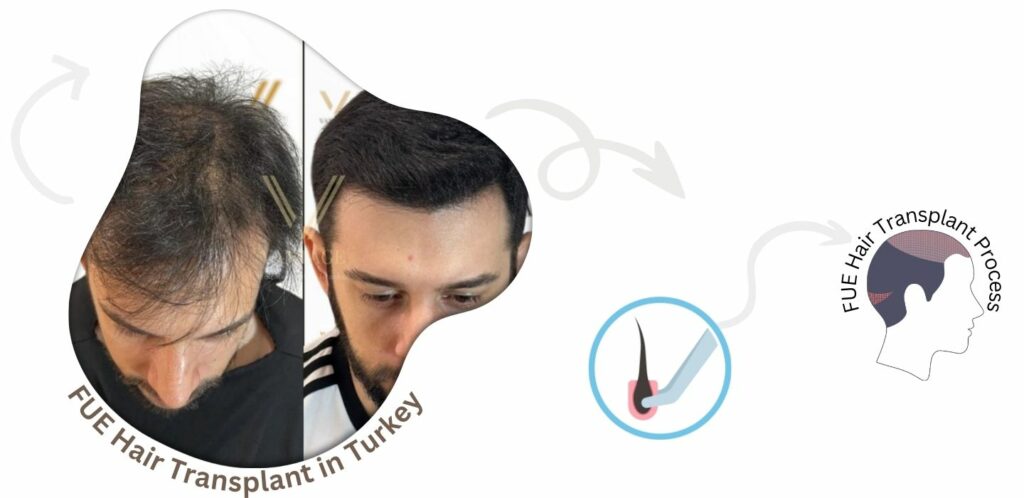
Before reading the entire process and details about FUE Hair Transplant in Turkey allow us to explain some basics about FUE hair Transplant.
Do you dream of having thick and luxurious hair? If hair loss is a constant concern, you’re not alone. Despite trying various remedies, you may need help getting everything to work. That’s where FUE hair transplant comes in. This sophisticated method guarantees natural-looking results that are not noticeable in your hair. The popularity of this innovative technique has skyrocketed globally. Turkey has emerged as a top destination for hair transplants due to its world-class medical facilities and affordable prices. Don’t let hair loss get in the way of your confidence. Book an appointment for a FUE hair transplant in Turkey today!
What Is FUE Hair Transplant?
If you are struggling with hair loss, the FUE hair transplant procedure can help you regain your confidence and feel great about your appearance again. This advanced technique involves extracting individual follicular units of hair and transplanting them into the areas of your scalp where you need a little extra coverage. By creating microchannels, up to 5,000 grafts can be transplanted in a single session, making it possible to cover larger balding areas in less time.
Our clinic understands that every patient has unique needs and preferences. That’s why we offer the option to get a hair transplant without shaving your head, which can relieve many people who don’t want to draw attention to their hair loss. Our medical consultants are here to answer any questions about the procedure and help you decide your treatment options.
Don’t let hair loss hold you back any longer. Contact us today to learn more about how a FUE hair transplant can help you look and feel your best.
3 Important Facts Behind FUE Hair Transplant In Turkey?
If you are curious about the facts behind FUE hair transplant in Turkey, you must have heard about Follicular Unit Extraction technique. This is one of the most popular hair transplant surgery methods in Turkey due to its modern applications. Turkish surgeons perform various hair transplantation methods to achieve successful hair growth and density in plastic surgery. If hair loss is your greatest fear, don’t worry, you’re not alone. Every year, many people around the world undergo hair transplant surgeries. Majority of them choose the FUE technique in Istanbul. Here are the main reasons behind FUE hair transplants:
1. Surgeons have been implementing advanced hair transplant techniques since the 1950s. However, FUE hair transplantation is a much more minimally invasive procedure than traditional ones. Because hair transplant surgeons remove hair follicles one by one from the donor site, the procedure results in minimal scarring and faster recoveries. [1]
2. It can be very challenging for European citizens to predict whether they can afford the cost of hair transplant surgery there. In contrast, most clinics in Turkey provide comprehensive services with all-inclusive packages for international patients. They offer free accommodation, transfers, medications, and more. Moreover, there are no hidden costs, despite the fact that hair transplant cost in Turkey is a third or a quarter of those in Europe. That’s why lots of individuals are coming to visit Turkish clinics for diverse medical procedures such as beard transplant, afro hair transplantation, eyebrow transplantation, body hair transplant to head and sapphire hair transplantation.
3. Turkish surgeons use advanced technology to identify common characteristics of hair disorders, aiming for natural results. All patients seek natural-looking outcomes from the DHI hair transplant in Turkey, Sapphire FUE method, or any other. They often desire transplanted hair that mimics the natural growth pattern, including a natural-looking hairline and hair type and direction matching existing hair. Experienced surgeons can meet these expectations in a cost-effective manner.
If you’re considering combining your medical procedure with leisure travel, consider visiting Turkey for your recovery. You can view our hair transplant before and after shots to get an idea of your potential hair transplant results.
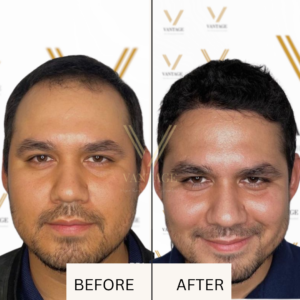
Cost of FUE Hair Transplant In Turkey?
Overall hair transplant cost in Turkey can vary depending on several factors, including the type of surgery, the chosen clinic, the reputation of the surgeon, and the complexity of the case. To assess the complexity of your case, you can determine your position on the Norwood hair scale. Turkey is widely recognized as the best hair transplant country, offering the best hair transplant prices. Vantage Clinic is among the top 10 hair transplant clinic in Turkey, known for its skilled medical team and excellent facilities.
The cost of an FUE hair transplant may range from $1,800 to $2,600 on average. However, it’s important to note that these prices are estimates and may vary for each individual. For example, some scalps may be suitable for Sapphire hair transplantation, while others may have to wait until they reach the hair transplant best age. If you want to learn more about the hair transplant from Turkey, please contact our medical consultants. You can learn more about the hair transplant FUE Turkey process, hair transplant prices at Turkish clinics, your stage on the Norwood scale, and more from us. Contact us now to have your first online consultation with our medical team and prepare a general treatment plan according to your photos that indicate your hair loss!If you want to learn more about the procedure, please contact our medical consultants.
How Much Is FUE Hair Transplant In Other Countries?
The cost of FUE hair transplant surgery varies from country to country. In the USA, prices can range from $4,000 to $15,000, depending on the clinic’s reputation and location. In the UK, it typically costs between £2,000 to £10,000. Prices in Western European countries are similar to those in the UK, ranging from €2,000 to €10,000 or more. While in Eastern European countries, the cost is lower, ranging from €1,500 to €5,000.
In India, the cost of FUE hair transplants is generally lower compared to Western countries. It is an affordable option for many, ranging from $1,000 to $4,000. However, it’s important to note that these are approximate figures. The cost varies based on individual factors such as the extent of hair loss, the number of grafts required, the surgeon’s expertise, and the clinic’s reputation.
It’s also important to consider that lower prices in some countries do not necessarily indicate lower quality. Many factors contribute to the overall cost, including the cost of living, labor costs, and government regulations. When considering a hair transplant, it’s crucial to research and choose a reputable clinic with experienced surgeons to ensure a successful and safe procedure.
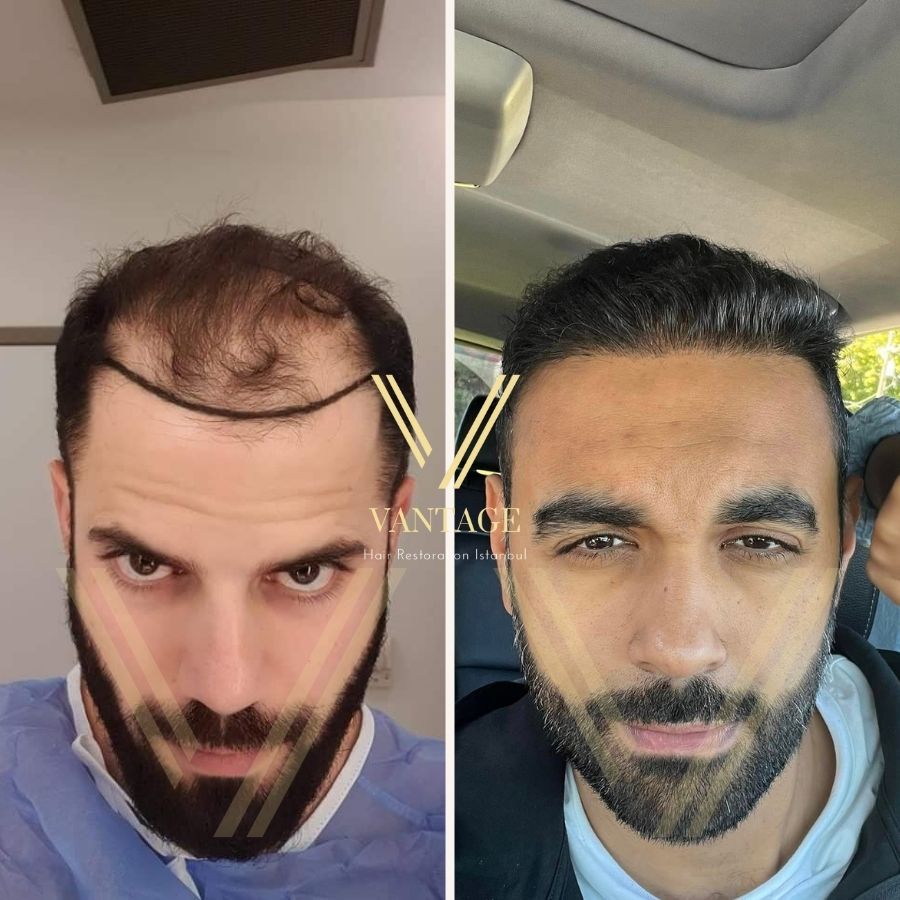
What Is Micro FUE Hair Transplant?
The Micro FUE procedure is a minimally invasive technique to collect hair. We use a smooth notch blade with a sharp, one-sided spinning edge. Once the cutting process is complete, the blade is set into a vibration mode where it no longer cuts. This way, we can access your hair shaft down to the follicle without severing anything. We also use the blade’s suction feature to pull out the hair as we release it gently. Unlike tweezers, this method removes the hair more naturally, leaving the hair shaft, follicle, and oil gland intact. With the Micro FUE procedure, you can achieve healthier and more natural-looking hair after your hair transplant.
What Is An Ice FUE Hair Transplant?
Ice FUE, also called frozen FUE, is an advanced hair transplant technique that provides superior outcomes. As the name suggests, Ice FUE is an improved version of the conventional FUE hair transplant procedure. The subtle difference between Ice FUE and the FUE technique significantly enhances the success rate of hair transplant procedures. Keeping the hair grafts in a cold environment improves the viability of the grafts, leading to a higher success rate of transplanted hair follicles.
What Is Sapphire FUE Hair Transplant?
Sapphire FUE closely resembles conventional FUE, with the critical distinction being the use of sapphire blades in the procedure. This unique feature sets Sapphire FUE apart from the traditional FUE method and contributes to an expedited recovery process. Additionally, using finely thin channels during the procedure facilitates the more accessible and precise implantation of collected grafts.
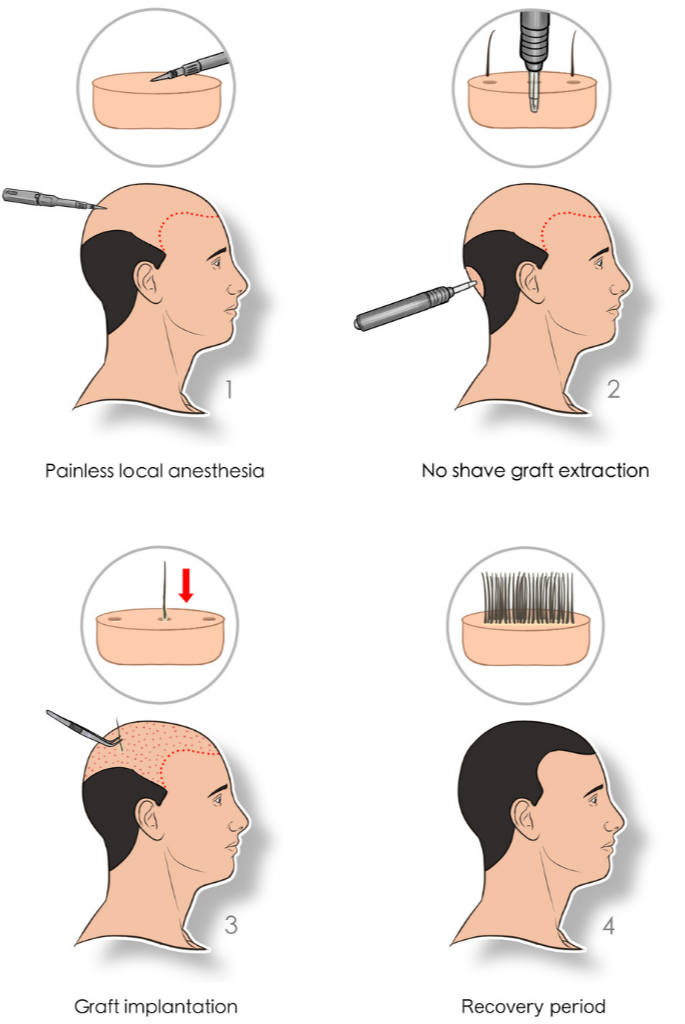
How Does FUE Hair Transplant Work?
During a FUE hair transplant, the following steps are usually taken in a sequence to ensure effective and successful results:
1. Local anesthesia is administered to reduce pain and discomfort during the procedure.
2. Healthy hair follicles are extracted from the donor area using a punch tool to create microchannels.
3. The collected grafts are stored in an appropriate environment to maintain quality while the recipient area is prepared.
4. Microchannels are created in the recipient area to transplant the collected grafts precisely.
5. The collected grafts are implanted individually into the microchannels of the recipient area.
6. A light dressing is applied to the donor area to prevent any risk of infection.
These steps ensure the hair transplant procedure is successful and the patient achieves the desired results.
How Many Grafts Are Needed For FUE Hair Transplant?
Since the FUE method is minimally invasive and requires the implantation of grafts individually, it’s possible to cover larger areas with FUE. How many grafts you will need for hair transplant is determined by your expectations and your current hair loss situation. Depending on your specific needs, up to 5,000 grafts can be transplanted in a single session.
How Long Does FUE Hair Transplant Take?
A FUE hair transplant can vary in duration, typically lasting 3 to 7 hours. This timeframe depends on the extent of hair loss and the specific FUE method chosen. Acknowledging that the duration may differ from one patient to another is crucial. Despite the procedure’s length, there’s no need for concern, as the operation is performed under local anesthesia, ensuring you won’t experience any pain.

Do I Need A FUE Hair Transplant?
If you’re facing hair loss, possess a healthy donor area for hair loss treatment, and maintain overall well-being, you qualify as an ideal candidate for a FUE hair transplant. Feel free to contact our medical consultation for further details on FUE hair transplant candidacy.
Can I Get An FUE Hair Transplant At 20?
While it is legally permissible to undergo an FUE hair transplant at the age of 18, many surgeons advise waiting until your mid-20s to 30s. This recommendation stems from the fact that hair loss patterns typically become more apparent and stable during this age. Therefore, even if your hair loss exhibits a distinct pattern and there are no underlying health conditions that impede a hair transplant, it is generally advisable to consider the procedure in your 20s.
This cautious approach allows for a more accurate assessment of the long-term progression of hair loss, enabling surgeons to make more informed decisions about the transplantation strategy. Don’t hesitate to consult with our medical consultant, who can evaluate your situation and provide personalized advice based on factors such as the stability of your hair loss pattern and overall health.
Does Insurance Cover FUE Hair Transplant?
Unfortunately, there are no insurance policies that cover expenses related to cosmetic surgery, including hair transplants. However, you may consider choosing an affordable hair transplant package if you are interested in the procedure. For instance, you can explore budget-friendly options in countries like Turkey. It is essential to note that affordability does not necessarily mean compromising on quality.
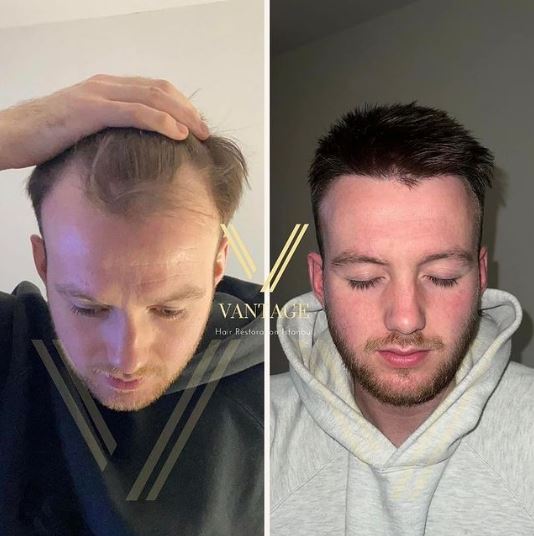
How Effective Is FUE Hair Transplant?
The FUE hair transplant is an innovative procedure that has been well-established for its high efficiency, boasting an impressive success rate of up to 98%. However, it’s crucial to highlight that various factors can significantly influence the procedure’s effectiveness. For instance, the surgeon’s expertise plays a vital role in ensuring the success of the transplant. Additionally, the durability of the grafts at the donor area and the post-transplant hair care routine are critical factors that can impact the procedure’s outcome. Therefore, it’s important to carefully consider these factors before undergoing the FUE hair transplant to ensure the best possible results.
What Is The Success Rate of FUE Hair Transplants?
FUE hair transplants have a success rate that ranges from approximately 98% to 100%, making them highly effective. This success rate is based on the number of hair grafts that thrive post-surgery, with an impressive 60-70% taking root in the transplant area.
How Long Does FUE Hair Transplant Last?
FUE hair transplant offers long-lasting results, but it requires meticulous upkeep and the careful selection of an experienced surgeon. Consider incorporating additional measures into your post-surgery routine to ensure your results are enduring. For example, using essential oils at specific intervals after the surgery and exploring supplementary options like PRP and mesotherapy can help improve your FUE hair transplant’s overall longevity and success. By following these practices, you can enhance the procedure’s impact and feel confident in your long-term results.
Is FUE Hair Transplant Permanent?
FUE hair transplant is a safe and effective treatment that offers a permanent solution to hair loss. However, to ensure the longevity of the treatment, it’s crucial to consider various factors, including your natural hair growth process. That’s why we recommend consulting with our hair transplant specialist. Our expert can help determine if FUE hair transplant is the right choice for you and discuss all the factors that can influence the permanence of the treatment. Don’t let hair loss hold you back any longer; contact us today to start your journey toward a full head of hair.
Does FUE Transplant Hair Fall Out?
After getting a FUE hair transplant, it’s common for the transplanted hair to fall out within the first few weeks of the procedure. This is referred to as “shock loss” and is a natural part of the healing process. The transplanted hair follicles undergo a temporary dormant phase during this stage before new hair growth begins.
However, there’s no need to worry as typically, new hair growth from the transplanted follicles can be expected within a few months after the initial transplant. Although the final results of an FUE hair transplant can take several months to a year to become fully apparent, the new hair gradually thickens and matures over time. So, it’s essential to be patient and allow your hair time to grow naturally.
Can You Still Get Bald After FUE Hair Transplant?
Getting bald after a FUE hair transplant is rare; however, it can happen for various reasons. These include overharvesting, selecting an unqualified surgeon, choosing a clinic with poor hygiene standards, inadequate aftercare, or even graft rejection for some individuals. However, you can take some simple precautions to prevent this from happening. First and foremost, selecting a qualified surgeon and a high-quality clinic is crucial to ensure you receive the best care. Additionally, providing proper care after the procedure can help prevent hair loss. If you have any concerns or questions about post-operation care, please do not hesitate to contact our aftercare hotline for assistance.
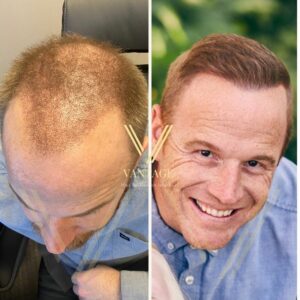
How Long Does FUE Hair Transplant Take To Heal?
During the first few days after the surgery, properly caring for yourself is crucial to ensure proper healing. The donor and recipient areas are expected to experience swelling, redness, and discomfort. Additionally, the scalp may develop small scabs where the grafts were implanted.
Typically, scabs in the recipient area start falling off within the first week, and the redness gradually decreases. To promote proper healing, it is essential to follow all of the post-operative care instructions provided by your surgeon. This may include gentle washing and avoiding strenuous activities.
It is usual for the transplanted hair to shed within the first month. This is a natural part of the process, and new hair growth will begin in the coming months. After the shedding phase, new hair will grow from the transplanted follicles. The development is usually gradual, and you may see noticeable results within 3-6 months.
Does FUE Hair Transplant Leave Scars?
FUE technique significantly reduces the likelihood of scarring and post-transplant discomfort, as it involves no incisions or stitches. Our skilled surgeons meticulously carry out this refined procedure, ensuring minimal downtime and possible side effects through their unwavering attention to detail.
How Long Does FUE Donor Shock Loss Hair Transplant Take?
FUE donor shock loss is a common phenomenon that can occur after a hair transplant procedure. However, it is usually a temporary condition that can vary in duration from person to person. Typically, the shock loss occurs within the 2nd to 3rd weeks after the FUE procedure. During this time, the transplanted hair follicles go through a dormant phase before they start to grow new hair, and some of the existing hairs in the donor area may be shed. It’s important to remember that this is a normal part of the healing process, and the hair will eventually grow back.
How To Hide FUE Hair Transplant?
A hair transplant is an excellent cosmetic surgery that can help you achieve a better appearance and a full head of hair. Although the process takes some time, it is worth the wait as it can give you the desired results. However, during the recovery period, temporary marks such as scabbing and redness can occur, which might not be pleasing to everyone.
When you get a hair transplant surgery, the newly implanted hair will grow slowly, which may cause an uneven appearance if you keep your existing hair longer. To avoid this, it’s recommended that you cut your hair short before the surgery to make the transition gradual. Additionally, if you have short hair after the surgery, people already used to your new appearance and won’t notice the change as much.
Can I Wear A Hat After FUE Hair Transplant?
One of the most convenient and influential ways to hide your head after FUE is wearing hats or headbands. However, it is crucial to choose safe options to prevent any damage to the transplanted area.
Fishing and bucket hats are the safest choices, as they provide full coverage and do not pressure the scalp. As time passes, around the 10th day post-surgery, you can transition to more stylish hats without compromising the healing process.
Hence, it is recommended to continue wearing a hat or a headband for at least two weeks post-surgery, especially when going out in the sun or dusty environments. After two weeks, it is safe to stop wearing a hat or a headband, but you should still avoid strenuous physical activities that may cause sweating or irritate the scalp.
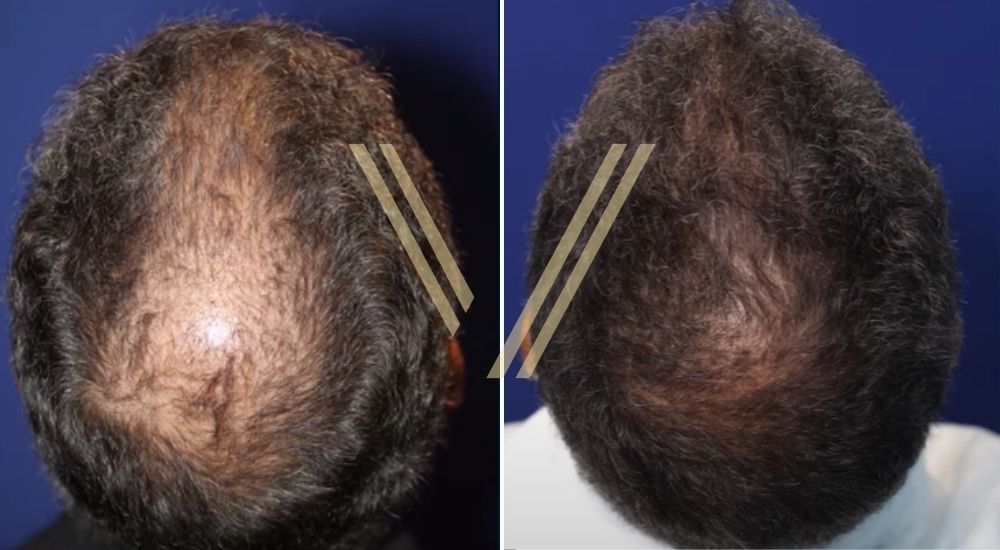
Methods under FUE Hair Transplant
If you are considering a FUE hair transplant, it is important to understand that the procedure involves the extraction of individual hair follicles from the donor area of the scalp and transplanting them to the balding area. The results of FUE hair transplant are usually the best, but the method used for each patient depends on several factors, such as the health of the graft, the extent of balding, and the location of the balding area.
What Is The Best FUT or FUE Hair Transplant?
Many patients find it challenging to choose between FUT and FUE hair transplant methods due to their respective merits. While the FUE technique offers a more natural-looking outcome, the FUT method is efficacious in improving the survival rate of hair grafts since it extracts hair follicles as strips from the donor area. It’s important to note that customized treatments are necessary to address individual variations in hair loss patterns and graft structures. Let’s explore further the nuances that distinguish these two methods.
What Is The Difference Between FUT And FUE Hair Transplants?
FUE and FUT have been proven to be effective ways for hair restoration. FUT is an older technique that involves removing hair in strips, which can result in a less natural appearance. However, it has paved the way for advanced hair restoration techniques. On the other hand, FUE is a newer and well-accepted method that involves extracting individual hair follicles. This results in a more natural look in both the donor and recipient areas.
While both methods are effective, it’s crucial to weigh the pros and cons of each before making a decision. If you want a seamless and natural outcome, choosing FUE would be wise. It offers a more natural look in both the donor and recipient areas, and it’s a contemporary method that has been well-received.
What Is The Best DHI or FUE Hair Transplant?
The choice between DHI and FUE hair transplant methods depends on your hair situation. Factors such as the growth and loss patterns of your hair and the structure of your hair grafts should be considered before making a decision. Our medical consultants are experts in this field and are available to help you with any information you need. Feel free to contact them if you have any queries regarding these methods and which would suit you most.
What Is The Difference Between DHI And FUE Hair Transplants?
DHI and FUE stand out as favored and sophisticated hair transplant methods, delivering high-quality results and earning global popularity. While both techniques yield picture-perfect outcomes, several factors distinguish them. Primarily, the extraction process, although individually based, employs distinct tools. The DHI method utilizes a specialized pen-like device called the Choi Pen, whereas FUE relies on a micro punch tool.
Furthermore, in the FUE technique, microchannels are created to implant collected grafts. In contrast, the DHI method requires no microchannel creation, resulting in minimal scarring. In a single session, the FUE method can transplant up to 5,000 grafts. However, due to its precision and expertise demands, the DHI method allows for a relatively lower number of grafts. Notably, the DHI technique proves more suitable for textured hair compared to FUE.
Choosing the optimal method hinges on your specific needs. Feel free to contact our medical consultants for more in-depth information about the procedures.
7 Important Instructions After FUE Hair Transplant
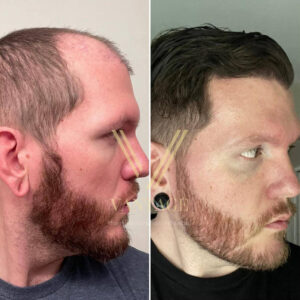
After an FUE hair transplant, it’s crucial to understand the different stages of recovery and regrowth you can anticipate. Initially, you might experience discomfort, swelling, and redness in both the recipient and donor areas. Prescribed medications are available to alleviate mild pain. However, it is essential to avoid picking or scratching to prevent any damage to the transplanted follicles as tiny scabs form around them.
During the first week, you may notice swelling around your forehead and eyes, which can be minimized by limiting activities and sleeping with your head elevated.
Between the second and fourth weeks, you might experience shedding of the transplanted hair and tiny scabs falling off. It is advisable to avoid strenuous activities during this period.
Between the second and fourth months, you’ll observe new hair growth, which may be fine initially, and shedding is considered a natural part of the process at this point as well.
Around three to six months, visible growth continues, and improvements in texture and thickness become apparent. Moreover, any redness in the recipient area may begin to diminish.
The final results become more evident up to twelve months, and you may schedule a follow-up appointment with your surgeon to assess progress and address any concerns.
It’s essential to be patient and allow your hair to grow naturally. Avoid picking or scratching the scabs to prevent graft damage. By following these guidelines, you can expect a noticeable change in your hair growth and texture. Please don’t hesitate to contact our aftercare hotline if you have any complications.
01. Scabbing After FUE Hair Transplant
A hair transplant is a fascinating procedure, and it’s common for people to want to speed up the recovery process. As a result, many patients naturally seek guidance on managing hair transplant scabs after the procedure. Gathering comprehensive information about scalp care following a hair transplant is crucial to ensuring a quick recovery and achieving natural-looking results.
The development of scabs is a natural part of the body’s protective mechanism. It acts as a barrier to shield the skin from exposed sores, which is particularly relevant after a hair restoration procedure involving multiple tiny incisions, which may result in bleeding and the formation of crusts. It’s essential to understand that scabs are expected after a hair transplant and will eventually disappear naturally with proper washing.
02. Sleeping After FUE Hair Transplant
After a FUE hair transplant, taking care of your scalp is crucial, even if it feels vulnerable. This is especially important when it comes to your sleep routine post-transplant. For the best results and hassle-free of your hair transplant, it’s recommended that you minimize any interaction with your scalp. To achieve this, it’s suggested that you sleep on your back and use pillows and cushions to support a comfortable sleeping position. If you want added comfort, you can delicately position a pillow under the nape of your neck, allowing your head to rest at a gentle incline of approximately 45 degrees. With this careful approach during sleep, you can ensure the best possible outcome of your hair transplant.
03. Washing Hair After A FUE Hair Transplant
After a hair transplant, the first 24 hours are crucial for healing. Our surgeon will have to apply a light dressing to protect the donor area, and during this time, you may feel tempted to touch or scratch your head. However, it is essential to avoid doing so, as the newly transplanted hair grafts can be sensitive at this stage.
After 24 hours, a medical team should carry out the first hair wash after a hair transplant. This is essential to ensure your scalp remains clean and scabs-free. Following this, you should wash your head once or twice daily for 15 days.
Although you can return to your regular hair-washing routine two weeks after your hair transplant, it is crucial to exercise caution during this period. The newly transplanted hair grafts remain sensitive, so follow the instructions provided by your medical team when washing your hair.
Begin by applying shampoo and moisturizer to your head, which will help soften any scabs that may have formed. Avoid rubbing or scratching your scalp, as this could damage the sensitive hair follicles. Once you have completed the shampooing process, rinse your head with warm water and gently pat it dry.
By following these steps, you can ensure that your hair transplant heals smoothly and that your new hair looks its best.
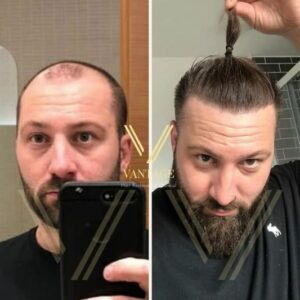
04. Shaving Head After FUE Hair Transplant
There’s no need to shave your head entirely for a FUE hair transplant. At Vantage Clinic, we provide an Unshaven/U-FUE hair transplant method specifically designed for male and female patients, allowing them to undergo the procedure without requiring a full head shave. This innovative approach prioritizes the preservation of existing hair and offers a discreet option for individuals seeking hair restoration while maintaining their current hairstyle.
05. Smoking After FUE Hair Transplant
When contemplating a hair transplant, it’s crucial to be aware that smoking can significantly hinder the procedure’s success. While this information might not be the most favorable, numerous research studies and surgeons’ experiences indicate that smoking can impede blood circulation, adversely affecting the transplant’s outcome. To optimize your chances of success, it is strongly advised to quit smoking both before and after the hair transplant, adhering to the recommended duration. By taking this proactive step, you enhance the likelihood of a positive outcome and can proceed confidently in your decision to undergo this transformative procedure.
06. Drinking Alcohol After FUE Hair Transplant
Before and after the FUE hair transplant, you should cut off alcohol consumption at least a week. Since alcohol thins blood, it may affect the efficiency of the procedure, hence the results you’ll get from the procedure. By keeping alcohol away, you may reduce the possible risks that might occur before and after the procedure.
07. Hair dying After FUE Hair Transplant
Getting a FUE hair transplant is the first step of a rejuvenating journey, so you might get excited to see results immediately and try different styling options with the new you. Hence, it’s important to be aware of some essential tips to ensure the best possible results. While you may be excited to see immediate results and try out new styling options with your new hair, patience is key.
Waiting for around 2-3 months after a hair transplant for your hair follicles to settle is crucial. After this duration, you can get a haircut (but avoid using a razor) and dye your hair. However, it’s recommended that you wait for at least six months before doing so.
If you have any questions or concerns after your hair transplant, our experienced medical consultants are always available to assist you. Their expertise can help you achieve the best possible results and ensure a successful hair rejuvenation journey.
By following these tips and seeking guidance from our medical consultants, you can achieve optimal results from your FUE hair transplant and enjoy the benefits of a successful hair rejuvenation journey.
07. Exercise After FUE Hair Transplant
After getting an FUE hair transplant, taking care of your scalp is crucial to ensure the grafts settle correctly. One thing to be wary of is excessive sweating. Sweating can negatively impact the health of the grafts and clog hair follicles. Therefore, it’s crucial to avoid activities that may exacerbate sweating.
Although exercise is vital to a healthy lifestyle, heavy exercise should be avoided for at least three weeks after the procedure. Mild exercise, such as walking, is permitted after this time, with regular workout routines possible after 4-6 weeks.
By following these guidelines, you can help ensure the success of your hair transplant and enjoy a healthier, happier life.
FUE Hair Transplant Before After Photos in Turkey
FAQs
Does FUE Hair Transplant Look Natural?
With a qualified expert and proper aftercare, FUE hair transplant offers natural results by enhancing hair growth with precision. Hence, the FUE hair transplant procedure involves using a specialized extraction tool to remove hair follicles from the donor area, which are then carefully implanted in the recipient area. The best part is that this technique leaves no visible scarring in the donor area, ensuring a natural look and feel.
Will Hair Grow Again After The FUE Hair Transplant Donor Area?
After undergoing an FUE hair transplant, it is important to realize that patience is key. The donor area takes some time to settle and start growing new hair. This is why it is essential for the donor area to undergo a recovery phase, which typically lasts 2-3 weeks post-procedure. Once the recovery phase is complete, the natural hair growth cycle resumes, and you can start to see new hair growth.
It is understandable to be anxious to see results, but there is no need to rush or worry. Allow your hair to grow naturally and at its own pace. By doing so, you give your hair the best chance to grow strong and healthy. Remember, the road to recovery after an FUE hair transplant may be a bit long, but the results will be worth it in the end.
Can I sleep sideways after a hair transplant?
As long as you do not put pressure on the recipient area, you can sleep as you wish. However, surgeons don’t recommend to sleep on your side for the first 10 days.
What if I accidentally touched my hair grafts after a FUE transplant?
Don’t touch the grafts in the first few days because they can become infected. In case of infection, contact the healthcare team.
Is it OK if I remove scabs after a FUE hair transplant?
Do not remove the scabs on your own as this can damage your scalp and newly placed grafts.
Are hair grafts secure after 5 days of a FUE hair transplant?
It takes about two weeks for the new transplanted grafts to become safe.
How long after a FUE hair transplant does it look best?
Majority of the patients see the optimum results between at least after one year and maximum of eighteen months. After a year, it’s expected to see matured, darkened, fully healed and thickened transplanted hair. You should have full hair coverage on your scalp.
Does FUE Hair Transplant Hurt?
When it comes to a FUE hair transplant, you may be relieved to know that the procedure itself is performed under local anesthesia and is, therefore, painless. After the procedure, you may experience some discomfort, but our surgeon will prescribe painkillers to alleviate any discomfort you may feel.
Does FUE Hair Transplant Last Forever?
With the help of an experienced hair transplant surgeon at a reputable hair loss clinic and proper hair transplant aftercare, FUE hair transplant can provide a long-lasting and natural-looking result. You can have peace of mind knowing that with the appropriate care and attention, you can regain a full head of hair and feel confident in your appearance again.
Does FUE Hair Transplant Work?
FUE hair transplant works for all eligible individuals, but choosing a qualified surgeon is crucial to achieve efficient results. Since FUE is a minimally invasive method, the outcome is seamless. Opting for an FUE hair transplant in Turkey can give you a success rate of up to 98%, which is relatively higher than FUT. However, it’s important to note that proper aftercare is equally essential and can significantly affect the results. If you have any questions about the procedure, feel free to ask.
Is FUE Hair Transplant Painful?
If you’re considering an FUE hair transplant, you might be worried about the pain and discomfort during the process. However, there’s no need to be concerned as your surgeon will use local anesthesia to numb the area, which will make the procedure pain-free. Although you may initially feel slight discomfort, it will gradually fade away. It’s important to keep in mind that you may experience some discomfort in the transplanted area after the surgery, but that’s completely normal and will subside with time. By focusing on the positive outcome of the procedure, you’ll be able to achieve your desired results and regain your confidence.
Is FUE Hair Transplant Worth It?
A FUE hair transplant is a fantastic option for those experiencing hair loss. It’s a permanent solution that can boost your confidence and is worth every penny. FUE hair transplant is a popular and effective option for achieving a natural-looking full head of hair. With the successful results, you’ll regain your confidence and won’t have to worry about spending money on expensive hair care and medications anymore. All you need to do is take care and style your natural hair. So, if you’re hesitant about investing in an FUE transplant, ask yourself if your happiness and self-esteem are worth it.
Is FUE Hair Transplant Safe?
When preparing for an FUE procedure, it is crucial to ensure the safety of the surgery. One common question that patients ask is whether a hair transplant is safe. Fortunately, this surgical option is generally considered safe.
The safety of an FUE hair transplant lies in its status as a minimally invasive procedure. During the surgery, hair follicles are redistributed from one area of the scalp to another. It is important to note that while the procedure carries minimal risks, it is not entirely risk-free.
Is FUE Hair Transplant Dangerous?
FUE is a hair transplant technique where individual hair follicles are extracted from the donor area and then transplanted into the recipient area. Like any medical procedure, FUE has some potential risks and complications, but overall, it is considered a safe and effective treatment for hair loss. However, it’s essential to note that the success and safety of the procedure depend on various factors, including the skill and experience of the surgeon who is performing the transplant.
Therefore, if you choose a qualified surgeon and a high-quality clinic that follows strict hygiene standards, you can minimize the risks associated with the procedure.
Sources
- Dua, Aman; Dua, Kapil1. Follicular Unit Extraction Hair Transplant. Journal of Cutaneous and Aesthetic Surgery 3(2):p 76-81, May–Aug 2010. | DOI: 10.4103/0974-2077.69015






